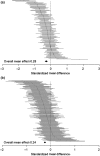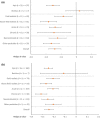Quantifying the impact of pesticides on learning and memory in bees
- PMID: 30449899
- PMCID: PMC6221055
- DOI: 10.1111/1365-2664.13193
Quantifying the impact of pesticides on learning and memory in bees
Abstract
Most insecticides are insect neurotoxins. Evidence is emerging that sublethal doses of these neurotoxins are affecting the learning and memory of both wild and managed bee colonies, exacerbating the negative effects of pesticide exposure and reducing individual foraging efficiency.Variation in methodologies and interpretation of results across studies has precluded the quantitative evaluation of these impacts that is needed to make recommendations for policy change. It is not clear whether robust effects occur under acute exposure regimes (often argued to be more field-realistic than the chronic regimes upon which many studies are based), for field-realistic dosages, and for pesticides other than neonicotinoids.Here we use meta-analysis to examine the impact of pesticides on bee performance in proboscis extension-based learning assays, the paradigm most commonly used to assess learning and memory in bees. We draw together 104 (learning) and 167 (memory) estimated effect sizes across a diverse range of studies.We detected significant negative effects of pesticides on learning and memory (i) at field realistic dosages, (ii) under both chronic and acute application, and (iii) for both neonicotinoid and non-neonicotinoid pesticides groups.We also expose key gaps in the literature that include a critical lack of studies on non-Apis bees, on larval exposure (potentially one of the major exposure routes), and on performance in alternative learning paradigms. Policy implications. Procedures for the registration of new pesticides within EU member states now typically require assessment of risks to pollinators if potential target crops are attractive to bees. However, our results provide robust quantitative evidence for subtle, sublethal effects, the consequences of which are unlikely to be detected within small-scale prelicensing laboratory or field trials, but can be critical when pesticides are used at a landscape scale. Our findings highlight the need for long-term postlicensing environmental safety monitoring as a requirement within licensing policy for plant protection products.
Keywords: agricultural policy; bees; cognition; insecticide; neonicotinoid; pesticide; pollination; pollinators.
Figures


Similar articles
-
Bumblebees Exposed to a Neonicotinoid Pesticide Make Suboptimal Foraging Decisions.Environ Entomol. 2021 Dec 17;50(6):1299-1303. doi: 10.1093/ee/nvab087. Environ Entomol. 2021. PMID: 34487150
-
No evidence for negative impacts of acute sulfoxaflor exposure on bee olfactory conditioning or working memory.PeerJ. 2019 Aug 12;7:e7208. doi: 10.7717/peerj.7208. eCollection 2019. PeerJ. 2019. PMID: 31423353 Free PMC article.
-
Solitary bee behaviour and pollination service delivery is differentially impacted by neonicotinoid and pyrethroid insecticides.Sci Total Environ. 2023 Oct 10;894:164399. doi: 10.1016/j.scitotenv.2023.164399. Epub 2023 May 26. Sci Total Environ. 2023. PMID: 37245806
-
Pesticide Exposure and Effects on Non-Apis Bees.Annu Rev Entomol. 2024 Jan 25;69:551-576. doi: 10.1146/annurev-ento-040323-020625. Epub 2023 Oct 12. Annu Rev Entomol. 2024. PMID: 37827173 Review.
-
Pesticide Exposure Assessment Paradigm for Stingless Bees.Environ Entomol. 2019 Feb 13;48(1):36-48. doi: 10.1093/ee/nvy137. Environ Entomol. 2019. PMID: 30508180 Review.
Cited by
-
Individual and combined impacts of sulfoxaflor and Nosema bombi on bumblebee (Bombus terrestris) larval growth.Proc Biol Sci. 2020 Aug 12;287(1932):20200935. doi: 10.1098/rspb.2020.0935. Epub 2020 Aug 5. Proc Biol Sci. 2020. PMID: 32752985 Free PMC article.
-
Bee Tracker-an open-source machine learning-based video analysis software for the assessment of nesting and foraging performance of cavity-nesting solitary bees.Ecol Evol. 2022 Mar 7;12(3):e8575. doi: 10.1002/ece3.8575. eCollection 2022 Mar. Ecol Evol. 2022. PMID: 35342575 Free PMC article.
-
Side-effects of pesticides on non-target insects in agriculture: a mini-review.Naturwissenschaften. 2022 Feb 9;109(2):17. doi: 10.1007/s00114-022-01788-8. Naturwissenschaften. 2022. PMID: 35138481 Review.
-
The Neurophysiological Bases of the Impact of Neonicotinoid Pesticides on the Behaviour of Honeybees.Insects. 2019 Oct 14;10(10):344. doi: 10.3390/insects10100344. Insects. 2019. PMID: 31614974 Free PMC article. Review.
-
Neither sulfoxaflor, Crithidia bombi, nor their combination impact bumble bee colony development or field bean pollination.Sci Rep. 2023 Sep 30;13(1):16462. doi: 10.1038/s41598-023-43215-6. Sci Rep. 2023. PMID: 37777537 Free PMC article.
References
-
- Arce, A. N. , David, T. I. , Randall, E. L. , Ramos Rodrigues, A. , Colgan, T. J. , Wurm, Y. , & Gill, R. J. (2017). Impact of controlled neonicotinoid exposure on bumblebees in a realistic field setting. Journal of Applied Ecology, 54, 1199–1208. 10.1111/1365-2664.12792 - DOI
Associated data
LinkOut - more resources
Full Text Sources
Other Literature Sources
